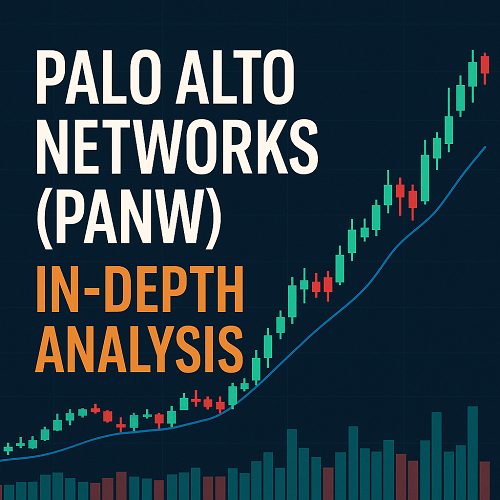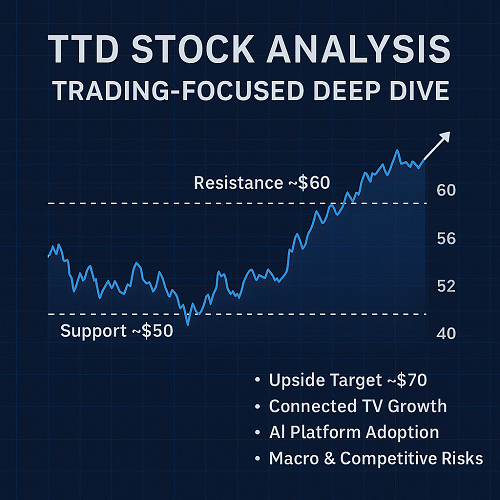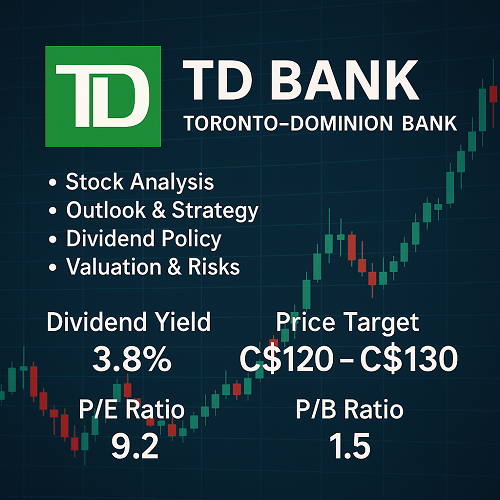Palo Alto Networks (ticker PANW) is widely regarded as a leader in enterprise cybersecurity. AsFor investors, keeping an eye on the PANW stock price is crucial as businesses and governments double down on digital transformation, cloud infrastructure, remote work, and AI-driven operations, demand for security, identity, and threat detection is intensifying.
From a strategic perspective, PANW is evolving from a firewall/orchestration vendor into a platform-centric security provider, integrating network, cloud, identity, and AI/ML-based threat hunting. If it executes well, the next leg of upside is in capturing high-margin recurring revenue and expanding deeper into identity/security operations.
However, the valuation is aggressive, and execution, especially around acquisitions and integration (e.g. CyberArk), must be flawless. For traders, PANW offers both momentum plays and swing trade opportunities, but with wider risk bands. This article seeks to provide the most comprehensive view available, combining fundamental, technical, and strategic insight.
Company Overview & Business Model
Origins & Evolution
- Founded in 2005 by Nir Zuk, a former network security engineer, PANW initially focused on next-generation firewalls.
- It went public in 2012, and later transitioned its listing to Nasdaq.
- Over time, it expanded via acquisitions and internal development into cloud, identity, and automation domains (e.g., Prisma, Cortex, etc.).
Core Offerings & Platforms
Palo Alto Networks’ offerings can be organized broadly into these pillars:
| Product / Domain | Description & Role |
|---|---|
| Next-Generation Firewalls & Network Security | Traditional but increasingly software-driven firewall and traffic inspection systems. |
| Cloud & SASE / Secure Access Service Edge | Prisma suite, securing traffic in SaaS, IaaS, hybrid cloud environments. |
| Endpoint / Threat Detection / XDR | Cortex platform (XDR, SOAR, automation) for detecting advanced threats, integrating with firewall/cloud data. |
| Identity / Privileged Access / Identity Security | With the proposed CyberArk acquisition, PANW aims to extend into identity and identity privilege management. |
| Threat Intelligence & Research | Unit 42 research is a recognized name in cybersecurity threat intelligence. |
The strategic shift is toward platformization — bundling multiple security domains, increasing cross-sell and stickiness, and converting more customers from point solutions to full-stack contracts.
Geographically, PANW has a global footprint, serving customers in 150+ countries, and counts among its clients many Fortune 100 enterprises.
Market Position & Competitive Landscape
Competitive Set
PANW faces strong competition from both established incumbents and newer challengers. Key players include:
- Fortinet (FTNT) — strong in firewalls and UTM (unified threat management)
- CrowdStrike (CRWD) — leadership in endpoint security, cloud-native threat detection
- Zscaler (ZS) — cloud access security broker (CASB), cloud-native architecture
- Check Point, Cisco, Juniper — legacy vendors still present
- Okta, CyberArk, BeyondTrust — identity/privileged access domain
- Newer AI / ML threat detection startups — potential disruptors
PANW attempts to differentiate by combining multiple security domains into a unified, AI-augmented platform. The addition of identity (via CyberArk) strengthens its position in the zero-trust / identity security space.
Barriers & Moats
- Scale & Installed Base: Many large customers already use PANW firewalls — upselling is more efficient.
- Ecosystem & Integration: Interoperability across network, cloud, endpoint, identity gives it an edge.
- R&D & Vision: Unit 42 and deep technical talent offer a continuous innovation moat.
- Switching Costs: Moving from one security architecture to another is costly and risky.
- Brand / Trust: Cybersecurity demands trust and reputation — PANW is well regarded.
Conversely, risks include commoditization, pressure from open-source substitutes, regulatory constraints, and execution failures in integrating acquisitions.
Financial & Operating Metrics
(This section is crucial because many competing pages give only basic data; here we go deep.)
Revenue, Margins & Growth
- PANW has consistently grown revenue in mid-teens percent territory.
- Its shift toward subscription & cloud/ARR revenue is accelerating, improving margin stability compared to hardware sales.
- In Q4 FY 2025, PANW posted 16 % revenue growth and adjusted EPS of $0.95, topping expectations.
- Annual Recurring Revenue (ARR) growth has been in the 30-40 % range in recent periods in cloud segments.
Margins: Despite investment in R&D and integration, adjusted EBITDA / operating margins are healthy, aided by high-margin software and subscription revenue.
Balance Sheet & Cash Flow
- The company maintains a strong balance sheet with liquidity to fund acquisitions.
- It generates significant operating cash flow, which supports reinvestment, M&A, and share buybacks.
- Debt is manageable given its operating scale, and its capital structure is relatively clean.
(For precise numbers, you should extract the latest 10-K / 10-Q; Nasdaq’s “Financials” dashboard currently reports “data not available” on their site.)
Key Ratios & Valuation Metrics
Here are important metrics and how PANW stacks up:
| Metric | Value (approx) | Interpretation |
|---|---|---|
| P/E (TTM) | ~120–130× | Very high — implies high growth expectations. |
| PEG Ratio | ~4–5× | Elevated — growth is expected to support valuation. |
| Price / Book | ~18× | Indicates market is pricing in strong intangible assets. |
| Return on Assets / Capital | ~3–4 % / ~10 % | Notably driven by software rather than asset-heavy business. |
| Short Interest | ~7–8 % of float | Significant short interest — both a risk and a potential squeeze. |
| Insider Ownership | ~2.5 % | Limited insider holdings, with some recent insider selling. |
These valuations reflect that investors expect strong, sustained growth—so missteps could be punished harshly.
Recent Performance & Guidance
- For the quarter ending July 2025, PANW delivered ~15.8 % revenue growth and EPS of ~$0.95.
- Guidance for fiscal 2026 revenue is in the range of $10.47B to $10.52B, which exceeded consensus.
- Remaining Performance Obligations (RPO) — a forward-looking bookings metric — rose 24 % year-over-year.
- Analysts have broadly reacted positively, upgrading price targets and acknowledging that the CyberArk acquisition is being executed from a position of strength.
These results suggest that PANW is not only growing, but its growth is accelerating, and management is gaining investor confidence.
Recent Developments & Catalysts
CyberArk Acquisition
One of the most consequential near-term catalysts is PANW’s planned acquisition of CyberArk, a leader in identity privilege and access management.
This move helps PANW plug a gap in its security stack (identity / privileged access) and positions it more strongly in zero-trust frameworks. Successful integration could unlock revenue synergies and increase stickiness. However, integration risk, cultural fit, and execution will be under scrutiny.
Platform Strategy & Bundling
PANW’s push to bundle offerings (firewall, endpoint, cloud, identity) into a unified platform is core to its long-term thesis. The “platformization” narrative is central in recent commentary and investor expectations.
This enables cross-sell to existing customers, reduces churn, and increases lifetime value.
Stock Split & Capital Return
In late 2024, PANW announced a 2-for-1 stock split, making shares more accessible to retail investors.
Additionally, PANW has authorized share buybacks and has enough cash flow to support both organic growth and capital return.
Insider & Institutional Activity
- Insider selling has been notable; e.g., Lee Klarich sold ~120,774 shares in October 2025.
- In the past 12 months, insiders sold ~$745M in shares.
- A small number of insiders have made purchases (very minimal).
- Institutional ownership is high, indicating broad confidence from funds.
Insider selling isn’t necessarily a red flag on its own, but with a high valuation, insider actions merit attention.
Technical Analysis & Price Projections
For active traders, the technical behavior of PANW offers several anchoring levels and patterns to watch.
Chart Patterns & Key Price Levels
- Support Zones: $180–$190 region is a critical support cluster, based on prior consolidations and pullbacks.
- Resistance Zones: $220–$230 has acted as resistance in recent runs.
- Breakout Points: A sustained break above $230 could trigger momentum continuation.
- Trendlines: The uptrend from the 2024 lows is intact; touches to this trendline often coincide with accumulation.
Momentum, Volume & Technical Indicators
- Relative Strength Index (RSI): Watch for overbought (>70) and oversold (<30) bands to time entries/exits.
- Moving Averages: 50-day and 200-day SMA/EMA crossovers can provide trend signal filters.
- Volume Surges: Breakouts with volume above average strengthen conviction.
- MACD / Signal Line: Divergence or crossovers can give early signals before breakout or pullback.
In sum: technical setups may give entry points with controlled risk if aligned with fundamental catalysts (e.g., earnings, acquisition news).
Scenario Projections
| Scenario | Timeframe | Projected Range | Rationale |
|---|---|---|---|
| Base (continued growth) | 6–12 months | $230 – $260 | Execution of CyberArk, continued ARR growth |
| Bull (accelerated growth, multiple expansion) | 12+ months | $270 – $320+ | Platform dominance, multiple re-rating |
| Bear / Pullback | 3–6 months | $150 – $180 | Market rotation, valuation contraction, execution missteps |
Traders should adjust these projections with dynamic risk tolerance and market conditions.
SWOT Analysis
Strengths
- Strong brand in cybersecurity and elevated trust
- Broad portfolio and growing platform mindset
- Recurring revenue base (subscriptions, cloud, ARR)
- High switching costs for customers
- Solid capital position for M&A and internal investment
Weaknesses
- Very high valuation — vulnerable to growth disappointments
- Execution risk with integration (CyberArk, consolidation)
- Low insider ownership — less alignment with shareholders
- Complexity of managing many product lines across cloud / identity / endpoint / network
Opportunities
- Identity security (via CyberArk) expansion
- AI/ML threat detection and automation as differentiator
- International & emerging markets security demand
- Regulatory and compliance tailwinds (e.g., data protection, zero-trust mandates)
Threats
- Intense competition from cloud-native, open-source, or startup security firms
- Macroeconomic / capital markets correction hurting tech multiples
- Cybersecurity failure or breach affecting confidence
- Regulatory scrutiny or geopolitical risks (e.g., US export controls)
Risk Factors & Red Flags
- Valuation Risk: With P/E >100×, any slowdown in growth or margin erosion could trigger sharp multiple compression.
- Integration Risk: The CyberArk deal, while attractive, adds complexity and execution burden.
- Insider Selling: Heavy insider sales may signal concern or profit-taking.
- Competition & Disruption: Rapid advances from nimble security startups could erode certain verticals.
- Operational Execution: Maintaining consistent execution across multiple business lines is nontrivial.
- Regulation: Cybersecurity is tightly regulated; compliance failures carry huge reputational risk.
Traders and investors should monitor catalysts and red flags actively and maintain disciplined stop-losses / hedges.
Trading Strategies & Execution Considerations
Here are some practical ideas for traders and investors:
- Momentum Breakout Entry
- Wait for a breakout above resistance (e.g., $220–230) on above-average volume
- Entry on retest of breakout with confirmation
- Stop-loss just below breakout zone
- Pullback Accumulation
- Use dips toward strong support zones (~$180–190)
- Enter in slices (staged entries)
- Use tight stops below support
- Catalyst Plays
- Enter ahead of earnings or acquisition milestones
- Use options or limited-risk structures to leverage directional conviction
- Hedged Positions / Pairs Trade
- Pair with short in a weaker security or index to isolate PANW’s alpha
- Use protective options (e.g. puts) beneath support levels
- Long-Term Buy-and-Hold
- For longer-term exposure, ensure you scale in and maintain suitable allocation
- Monitor valuation; consider trimming at stretched multiples
In all cases, risk management (position sizing, stop-loss discipline, exposure limits) is critical given the high valuation and volatility environment.
Forecasts & Analyst Consensus
- Analyst Ratings: MarketBeat consensus: “Moderate Buy.”
- Price Targets: Many analysts are in the $220–$300+ range, depending on growth execution assumptions.
- Growth Projections: Earnings growth in the mid-to-high teens is expected; cloud / subscription revenue is projected to outpace hardware.
- Valuation Re-rating: The assumption is some multiple expansion will accompany execution and investor confidence.
- Risks in Forecasts: If growth underdelivers or integration drags, forecasts may require downward revision.
Given recent guidance beating expectations, there is room for upside to consensus, but the margin for error is tight.
Summary & Final Recommendation
Palo Alto Networks (PANW) is a compelling, high-conviction name in cybersecurity if one believes in the secular growth of cloud, zero-trust architecture, identity, and threat automation. Its strategy to become a full-stack security platform is plausible, and the CyberArk acquisition offers a meaningful gateway into identity privileges.
However, the valuation is aggressive, and any misstep in integration, growth, or margins may lead to sharp multiple contraction. For traders, PANW offers excellent momentum potential, especially around catalysts, but must be approached with tight risk control. For long-term investors, anchoring position size and monitoring valuation metrics will be key.
Overall Recommendation:
- For traders: Watch for breakouts with volume, manage risk with tight stops, and consider catalyst-driven swings.
- For longer-term investors: Accumulate on weakness, monitor execution progress, and avoid overexposure given valuation sensitivity.





 XAUT-USD
XAUT-USD  AMD
AMD  MARA
MARA  SHOP
SHOP  BULL
BULL  CL=F
CL=F